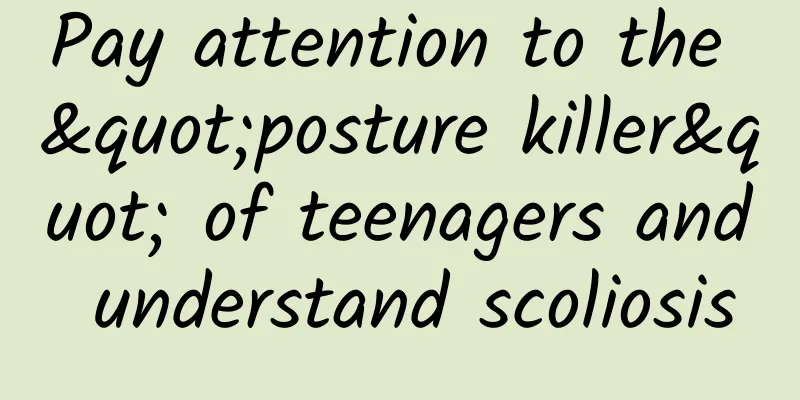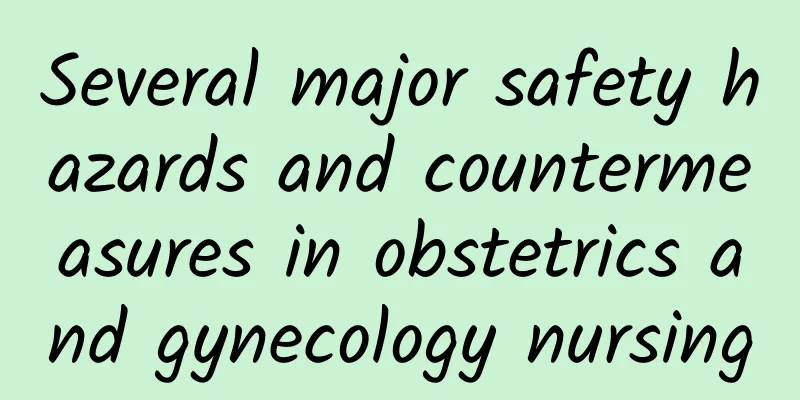Pay attention to the "posture killer" of teenagers and understand scoliosis

|
Author: Zhang Yayun, The First Affiliated Hospital of Nanchang University Reviewer: Zhu Jiaojiao, deputy chief nurse, the First Affiliated Hospital of Nanchang University I wonder if you have noticed that modern people's lifestyles have changed a lot. For example, the time spent studying or working at a desk has been significantly extended, and more and more teenagers have poor posture due to long-term sitting posture. Sometimes parents suddenly find that their children's bodies habitually lean to one side, or their shoulders are uneven, or their backs are asymmetrical. This is not a simple posture problem. You must be alert, as this may be a sign of scoliosis. Figure 1 Copyright image, no permission to reprint What is Scoliosis? Scoliosis is a three-dimensional deformity of the spine, characterized by a certain section of the spine permanently deviating from the midline of the body, causing the spine to bulge out in an arc or "S" shape. A normal spine should be a straight line when viewed from behind, and the two sides of the trunk should be symmetrical. If a person's shoulders are not at the same height when viewed from the front, or if the back is uneven when viewed from the back, "scoliosis" should be suspected. Figure 2 Copyright image, no permission to reprint What are the dangers of scoliosis? In China, the incidence of scoliosis among adolescents is 2% to 4%, second only to obesity and myopia. Scoliosis has become the third largest disease endangering young people in my country, and its incidence has continued to increase year by year in recent years. Because the clinical symptoms of scoliosis are hidden, it is difficult for parents and children to detect it in the early stages of the disease. It will not be discovered until the child develops deformities such as spinal curvature and chest deformation. In more serious cases, the child may develop "razor back" symptoms (i.e. uneven shoulders, a razor-like bulge in the back, a collapsed chest and a bulge on one side, a tilted pelvis and lameness), which greatly affects the appearance. Due to physical deformities, some children are prone to lack of confidence or psychological barriers when communicating with others. In severe cases, this can cause the child to become withdrawn. Scoliosis has a great impact on the daily life and learning of adolescents. If it is not intervened in time, severe cases may need to wear a spinal orthosis every day, or even undergo surgery to correct the curved spine. The harm of scoliosis is far more than that. When scoliosis occurs in the thoracic segment, it is also easy to cause thorax deformity, reducing its volume, which in turn affects the cardiopulmonary development of adolescents and induces cardiopulmonary diseases. In addition, due to changes in spinal balance and uneven force, spinal degeneration in patients with scoliosis will accelerate. Mild cases will cause back pain after sitting for a long time; more serious cases may experience spinal stenosis and nerve compression, manifested as back and leg pain, lameness, and even paralysis. In more serious cases, their cardiopulmonary function is impaired, and their activity endurance is weakened, causing the child's body to be unable to develop normally. What causes scoliosis? Scoliosis can be clinically divided into two categories: "structural" and "non-structural". Structural scoliosis refers to the three-dimensional deformation of the spine itself, which has nothing to do with the patient's bad posture. About 80% of patients have idiopathic scoliosis, the cause of which is unknown and may be related to genetics. Non-structural scoliosis, which we commonly call "pseudo-scoliosis", has no structural problems with the spine itself. It is usually caused by poor posture, or asymmetry of structures outside the spine such as pelvic tilt, unequal length of lower limbs, lumbar kyphosis, etc., which gradually leads to the appearance of scoliosis. How to detect scoliosis early? The easiest way to detect scoliosis early is the forward bending test. Let the child stand barefoot on the ground, expose his back, stretch his legs together, bend forward, and let his hands hang naturally. Parents should observe the child's back from the front or back. If the back is found to be asymmetrical and uneven on both sides, and the spine is not in a straight line in the middle of the torso but is offset to one side, then there is a high possibility of scoliosis and the child should be taken to the hospital for examination as soon as possible. What should I do if I suspect my child has scoliosis? Once you suspect your child has scoliosis, it is recommended that you visit a spinal specialist clinic as soon as possible. The Cobb angle is a method of measuring the angle of scoliosis, which is used to assess the severity of scoliosis. Clinically, professional doctors will decide whether surgery is needed based on the Cobb angle and the classification of scoliosis. Generally speaking, if the Cobb angle is <20°, close observation should be performed; if the annual progression is >5° and the Cobb angle is >20°, or the Cobb angle is between 20° and 40°, brace treatment should be performed; if the Cobb angle is >40° and the annual progression is greater than 5°, surgical treatment should be performed. How can teenagers prevent scoliosis? 1. Maintain correct posture every day Parents should urge teenagers to develop good posture and form habits, from sitting, standing, sleeping to walking posture. In addition, the bed should not be too soft and the pillow should not be too high when teenagers sleep. Figure 3 Copyright image, no permission to reprint 2. Develop good living habits The weight of the schoolbag for teenagers should not be too heavy, and they should try to choose a backpack. This can ensure that the shoulders are evenly stressed, the paraspinal muscles of the spine are in a balanced state, and it is conducive to maintaining the normal shape of the spine. Figure 4 Copyright image, no permission to reprint 3. Scientific exercise While correcting their posture, young people should actively participate in exercise. This is one of the important ways to prevent scoliosis. When exercising, exercise the back muscles and waist back muscles more often, which will help correct the scoliotic spine and reduce the incidence of neck pain and waist back pain. During exercise, try to fully exercise all the joints and muscles of the body, which will help reshape the body's balance. 4. Rationally match food to ensure balanced nutrition Teenagers should strengthen calcium supplementation, increase the intake of calcium-rich foods, and get more sun exposure to ensure the absorption of nutrients and promote healthy bone development. At the same time, teenagers should avoid overeating and prevent overweight or even obesity, so as to avoid excessive body load that affects the healthy development of the spine. |
<<: Skeleton's "Transformers" Show: How Broken Bones Transform into Gorgeous Shapes
>>: The wisdom of preventing falls for the elderly: Be a healthy and happy "tumbler"
Recommend
How long will it take to give birth if you have spotting at 39 weeks?
Throughout the pregnancy, mothers are always full...
What is the reason for sexual indifference after giving birth?
Everyone knows that a good sex life is very neces...
What should you pay attention to after ovarian cyst surgery?
With the development of science and technology, m...
What are the ingredients for breast enhancement in traditional Chinese medicine?
Flat chest is a big worry for women, because brea...
Many scientific studies have shown that "abdominal obesity affects brain cognition" Try these tips to help lose weight in your internal organs →
How to make a handsome young man Transform into a...
Children's fever-reducing medicine is very popular. Are you using it correctly? ---Merrill Lynch
This is the 4184th article of Da Yi Xiao Hu These...
Benefits of menstrual red dates and ginger soup
Menstrual problems are a problem that every femal...
There are more reasons to drink cold drinks and eat ice cream! It really doesn't hurt your stomach, but these two factors may be the reason for your diarrhea
Sunny day in August It finally looks like summer ...
The difference between women with and without rings
Inserting an IUD is a contraceptive method chosen...
How many grams does a Zongzi weigh? Why do we eat Zongzi during the Dragon Boat Festival?
Every year at the beginning of the fifth lunar mo...
What is the reason for the girl's left lower abdominal pain
In our daily lives, abdominal pain occurs many ti...
Can a cold delay your period?
Under normal circumstances, a cold will not cause...
Does having more body hair make a woman more sexually active?
Many people think that if a person has more body ...
Is it fun to travel to Mohe in December? What to wear in Mohe in winter
Friends who have studied geography know that Mohe...







![[Health Science] Do you know the dangers of sleep apnea?](/upload/images/67f19f326ebe7.webp)

